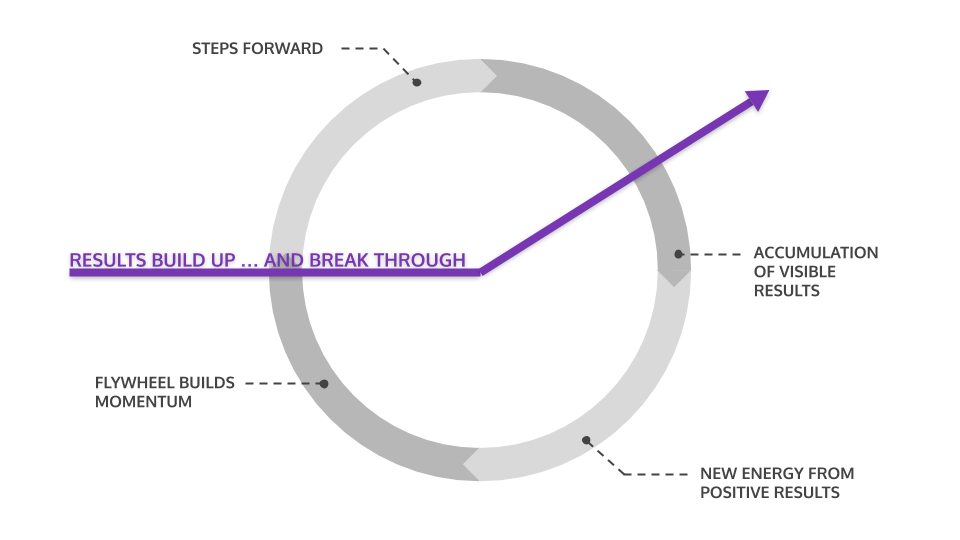SEO is Today’s Most Cost-Effective Marketing Channel
For years, Profound Strategy has created most of our clients’ best-performing organic content. We repeatedly produce high-performing content that continues to grow over time. And that’s why I can say, without hesitation or qualification, that SEO can very well be the most cost-effective marketing channel today.

Yes, many SEO projects fail to deliver as time and resources are wasted on low-impact (or no-impact) SEO tactics, mediocre content, etc. “Doing SEO” does not guarantee success.
However, doing SEO the right way pays long-term dividends.
Done right, SEO has no match when it comes to driving high-value traffic and ultimately producing a better ROI than any other digital marketing channel.
The Flywheel Effect of SEO Done Right
The flywheel effect is a concept popularized in the book, Good to Great. It describes repeated, small efforts that build upon each other over time, until a breakthrough occurs and sustained momentum takes over. Afterward, a small effort is all it takes to continue, or build upon, that momentum in perpetuity.

The Flywheel Model from Jim Collins’ Good to Great.
One reason why SEO is the most cost-effective marketing channel today is that SEO is perhaps the only one in which continued traffic growth is possible through a sustained baseline effort.
Twenty-five or 50 pieces of extremely helpful content published in a six-month period can continue to generate loads of organic traffic years later. Subsequent excellent content builds upon that breakthrough momentum and propels the website forward.
“You’re pushing no harder than during the first rotation, but the flywheel goes faster and faster. Each turn of the flywheel builds upon work done earlier, compounding your investment of effort.” — Jim Collins
The idea of the flywheel effect in SEO is that a marketer can produce a certain amount of content and, once it is noticed by Google, the ROI actually increases over time—a situation that is not possible in other marketing channels.
The ROI on Paid Search Only Gets Lower
By contrast, consider paid search: If you spend $X, you get Y (amount of traffic). The moment ad spend is discontinued, traffic stops. It’s the case for any paid channel, but especially paid search.
Paid search costs rise every year, and persistent marketers increase their ROI by optimizing an ad or campaign. But in the long-term, it gets more difficult to grow ROI, because, eventually, they cannot optimize further. At that point, the only choice is to spend more to get more, or continue to create additional paid campaigns.
On the other hand, the high-quality SEO content you publish today may take a couple of months to begin generating organic traffic, but it will drive increasing traffic six, nine, or 12 months and beyond.
Google’s Revenue Depends on Organic Search
That fact that Google’s ad revenue depends on high-quality organic search means Google is highly motivated to continue improving the organic search experience for users. This is yet another reason that smart SEO investments won’t be wasted, and the flywheel can continue to spin.
For example, nobody watches TV for the commercials (except for the Super Bowl!), but broadcast TV stations are built around ad revenue. Selling those ad spots requires a reliable viewership, and creating that audience requires a schedule of amazing shows.
Search engines face the same dynamic.
No one opens a web browser for the banner ads, but 71% of Google’s revenue comes from PPC sales. Selling those ad spots requires Google to maintain an exceptional user experience.
If the user experience that Google provides in search ever begins to collapse, Google’s advertising revenue goes away. If its SERPs don’t answer users’ needs, those users will turn to other sources—Bing for search, Travelocity or Kayak for flights, etc. And if viewers go elsewhere, Google’s revenue will dry up.

Admittedly, search is Google’s to lose at this point. They own the search market.
A big part of creating the best user experience, and the most helpful SERP, is still organic search results. That means Google needs to serve up the best content for each user need. SEO is a long-term play for Google, which means that if you engage with SEO the right way, it can be a highly effective marketing channel for you for the long-term, too.
(Yes, Google is invading more and more industries and no-click searches are slowly climbing, but—especially for many B2B brands—organic search results still dominate SERPs and are still the best answer to most user needs.)
Get Beyond “Just OK” SEO
Lots of companies are trying to figure out SEO, but many of them still waste their time and effort on old-school tactics that won’t move the needle, and on content that’s just okay. The good news is you are here reading this, and you’re one step closer to doing SEO right!
You’re reimagining what SEO is and what can be achieved. You know that only the best content competes and wins in the SERPs. And, if you approach SEO from that standpoint, you have a huge opportunity to compete in a way that matters, and move ahead of competitors who are still stuck in outdated SEO strategies and tactics.
How do you get started? Check out our Modern Guide to High-Impact SEO for step-by-step guidance on everything from modern keyword research through to effective content creation.
What's Next?
Profound Strategy is on a mission to help growth-minded marketers turn SEO back into a source of predictable, reliable, scalable business results.
Start winning in organic search and turn SEO into your most efficient marketing channel. Subscribe to updates and join the 6,000+ marketing executives and founders that are changing the way they do SEO:
And dig deeper with some of our best content, such as The CMO’s Guide to Modern SEO, Technical SEO: A Decision Maker’s Guide, and A Modern Framework for SEO Work that Matters.




